
Pioneering Stock
In 1623, the sailing ship ANNE left England, bound
for colonial America. Among the passengers landing
in New England was William Heard, whose
family settled in Massachusetts and played an active
role in forging the new American democracy.
Some three centuries and seven generations later,
the pioneering legacy of the Heard family continued
to exert itself, this time in the distant desert
climes of Arizona. On the eve of the 20th century,
in the territorial capital of Arizona, William's
descendant, Dwight B. Heard, would become a major
force in the life of the new-born community. His
accomplishments form a chronicle of the early
history of Phoenix, the Valley, and the State of
Arizona. One chapter of this record reveals, in
microcosm, the breadth of Heard's dramatic influence
upon the shape of this emerging region, as his
efforts in politics, business, and the arts
converged. It lead to the creation of one of the
most distinctive collections of residential
architecture in the city of Phoenix -
Alvarado.
An Ancient Source Of Life
The life of present-day Phoenix commenced in 1867,
when Civil War soldier, prospector, promoter, and
speculator John William, known as Jack Swilling,
began to irrigate and cultivate land along the
northern bank of the Salt River. Inspired by the
remnants of ancient Hohokam canals, Swilling
established a company to supply the U.S. Army troops
at Camp McDowell, twenty miles to the northeast. His
activities attracted additional settlers, and by
1870, the community boasted a population of 235 with
1,500 acres of land under cultivation. In that same
year, the terrain was surveyed and laid out in a
square-mile grid pattern. With the reservation of a
central townsite, Phoenix was born.
Because the arid climate required extensive
irrigation to support crops and sustain the
population, Phoenix did not become an instant
boomtown. Rather, the town experienced steady growth
as a supply center for military, government, and
mining operations. Weathering the economic
depression of the mid-1870's, Phoenix began to
flourish at the end of the decade as rising
agricultural prices led to prosperity.
Patterns of development emerged with the growth of
thriving commercial and residential districts along
the major north-south thoroughfare, Center Street,
now Central Avenue. Roughly bounded by Central
Avenue, Third Street, Oak Street and Palm Lane, the
future site of Alvarado was two miles north of the
city's center, and still just vacant desert. But
rapid growth soon would propel development
northward. In 1879, the Southern Pacific Rail line
made Phoenix more accessible with the extension of
its line to within thirty miles south of town. With
incorporation of the city in 1881, the stage was set
for a dramatic new era.
In 1885, completion of the Arizona Canal provided
the Valley with 41 additional miles of irrigation,
opening up 100,000 acres of desert land to
agricultural development. The economic impact of the
Canal and the promotional efforts of its builder, W.
J. Murphy, brought a period of rapid growth and
"boosterism" to Phoenix and the Sale River Valley.
Phoenix was selected as the Territorial Capital in
1889. A flurry of municipal activity established
water, sewer, gas, and electric utility franchises.
The city's population tripled between 1885 and 1890.
Visions In The Desert
Arriving in Phoenix in 1895, Dwight B. Heard quickly
assessed the Valley's great potential and grasped
the limitations imposed by the cycle of floods and
drought which plagued the Valley. Motivated by
investments in land and agriculture, he became an
active force in efforts to promote federal projects
that would harness the Valley's water. With
successful passage in 1902 of the National
Reclamation Act, Heard applied his efforts locally
where he served as a county water commissioner,
helping to lay the groundwork that led to
construction of the Roosevelt Dam. Completed in
1911, the dam tamed the waters of the Salt River,
transforming the Valley by providing both stable
irrigation and protection from inundating floods.
In 1903, Heard and his wife Marie constructed a
6,000-square-foot Spanish Colonial Revival
mansion they named "Casa Blanca." Located at the
corner of Monte Vista and Central, the home
was the cornerstone of future Alvarado and was a
frequent stop for visitors and dignitaries from
throughout the nation. Sensing the promise this
north central location held, Heard purchased the
entire quarter section of land on which his estate
was located. In 1909, he subdivided the 160 acres,
which ranged from Central Ave. to Seventh
Street and McDowell Road to Oak Street, in to 32
parcels of five acres each. Intended for upscale,
estate size homes, the project, named Los Olivos,
was the most prestigious of the early suburban
homesite subdivisions with the largest lots
available. Preparing the project for sale, Heard
provided numerous plantings throughout the
subdivision, including hundreds of palm trees.
Information, maps and photographs provided courtesy:
Historic Preservation Office of the City of Phoenix
Neighborhood Services Department
200 West Washington Street
Phoenix, Arizona 85003
(602) 261-8600

